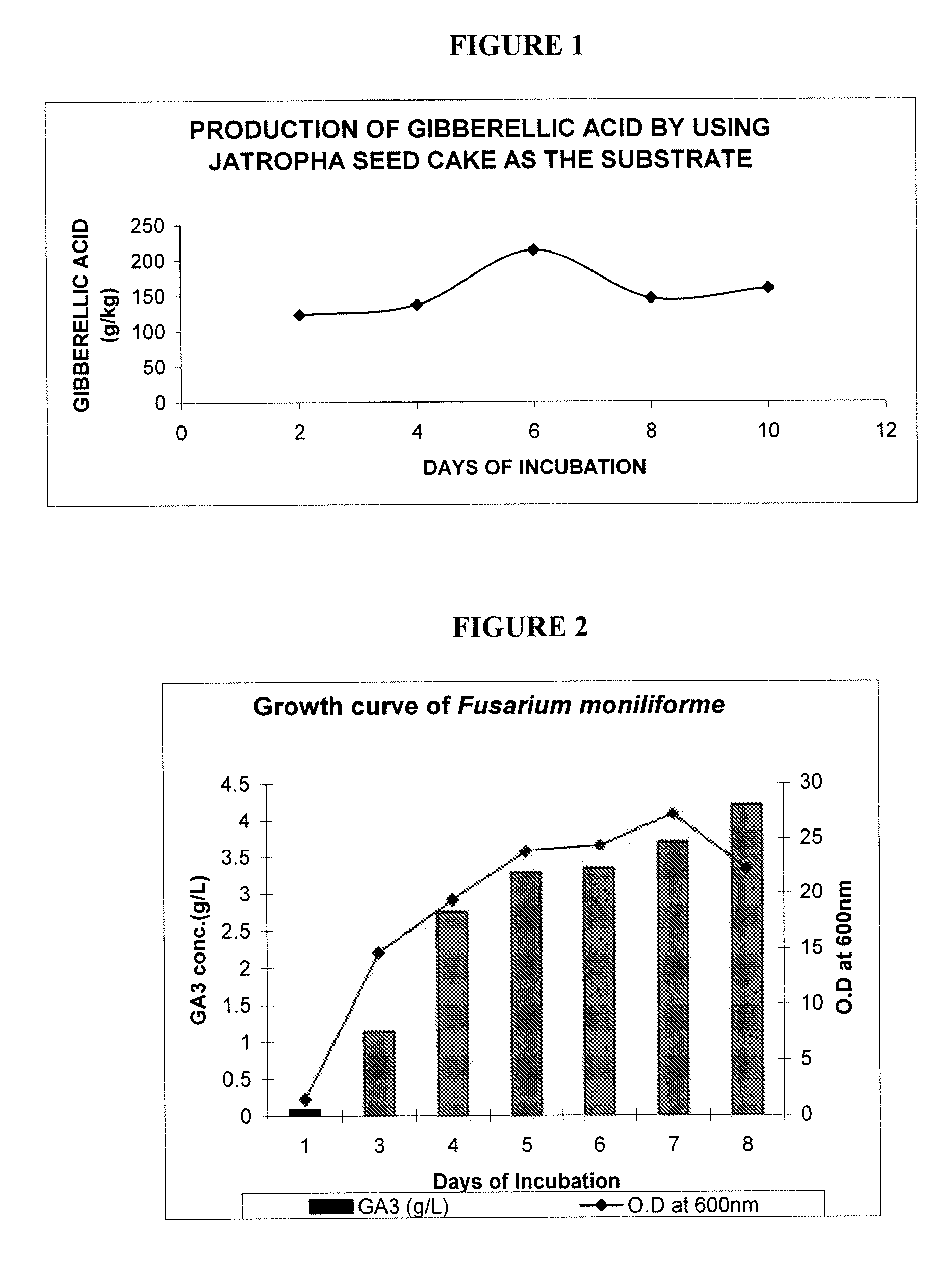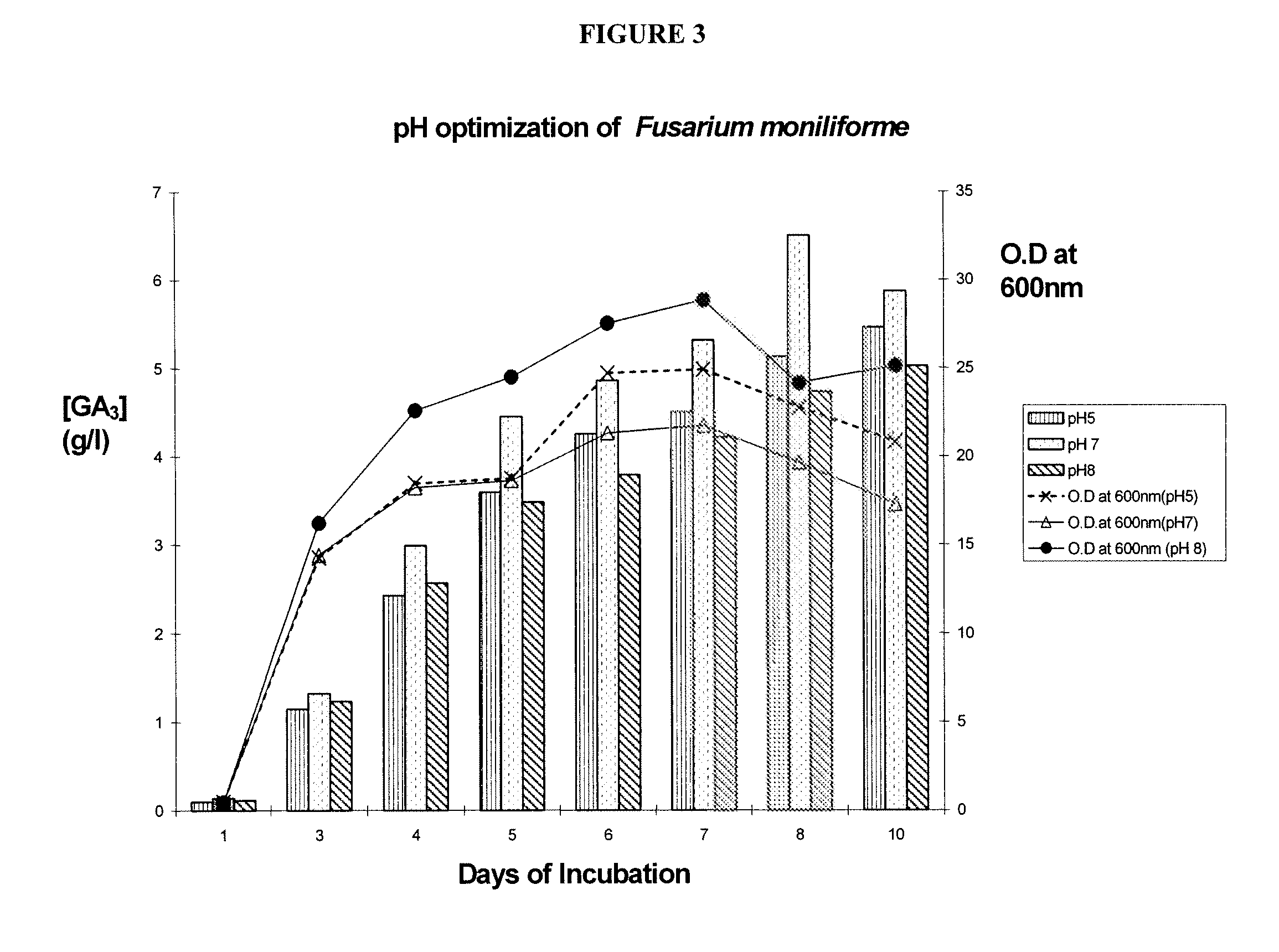Process for gibberellic acid production with “Fusarium moniliforme” strains
a gibberellic acid and fusarium moniliforme technology, applied in biochemistry apparatus and processes, microorganisms, microorganisms, etc., can solve the problems of high cost, limited use of premium crops, and inability to economically compete with fermentation techniques for chemical synthesis and production,
- Summary
- Abstract
- Description
- Claims
- Application Information
AI Technical Summary
Benefits of technology
Problems solved by technology
Method used
Image
Examples
example 1
[0071]Fusarium moniliforme NCIM 1100 was obtained from National Collection of Industrial Microorganisms, Pune, India. The strain was cultured and maintained on sterile potato dextrose agar (PDA) slants. Unless otherwise indicated, the media used for production of gibberellic acid was Czapek-Dox (Himedia-M076) and the culture was incubated at 30° C. for 10 days on as shaker incubator at 150 rpm.
example 2
Solid Substrate Fermentation with Wheat Bran
[0072]To 50 g wheat bran, 30 ml of a mineral salts solution (copper sulphate, 0.007 g; ferric chloride, 0.007 g; and zinc sulphate, 0.007 g, dissolved in 1 liter of 0.2N HCl) was added and mixed well. The mixture was then distributed equally into five flasks and sterilized at 15 PSI for 30 min. The autoclaved wheat bran in each flask was inoculated with 10 ml of 6 days old F. moniliforme culture from Czapek-Dox broth, mixed thoroughly and were incubated at 30° C. for 10 days at a 45° angle. Yield was determined by the method of Berrios et al., as described below.
[0073]
Yield of GA3 from wheat bran under SSF, over time.GA3 concentration (g / kg)Days ofin solid substrateincubationfermentation (wheat bran)5296327338349391039.4
example 3
Analytical Procedures
[0074]GA3 was determined spectrophotometrically by the method described by Berrios et al. (Biotechnology Letters 26: 67-70, (2004)) at 254 nm. GA3 was also determined by HPLC at 206 nm using a C18 column with methanol:water (3:1) as the mobile phase at 1 ml / min flow rate, as described by Sharma et al. (Biotechnol. Appl. Biochem., 39, 83-88 (2004)). The retention time of GA3 is 3 minutes under these conditions.
[0075]GA3 was also detected by TLC as described by Puchooa et al. (African Journal of Biotechnology, 3(4): 248-252 (2004)). The culture filtrate obtained after fermentation was subjected to extraction and purification as described below. The obtained residue was dissolved in ethanol and separated by TLC using isopropanol-ammonia-water (10:1:1, v / v / v) as mobile phase. The plates were sprayed with 3% sulphuric acid in methanol containing 50 mg ferric chloride and heated in an oven at 80° C. for 10 min. GA3 fluoresce and appear as a greenish spot under UV ligh...
PUM
| Property | Measurement | Unit |
|---|---|---|
| temperature | aaaaa | aaaaa |
| temperatures | aaaaa | aaaaa |
| pH | aaaaa | aaaaa |
Abstract
Description
Claims
Application Information
 Login to View More
Login to View More - R&D
- Intellectual Property
- Life Sciences
- Materials
- Tech Scout
- Unparalleled Data Quality
- Higher Quality Content
- 60% Fewer Hallucinations
Browse by: Latest US Patents, China's latest patents, Technical Efficacy Thesaurus, Application Domain, Technology Topic, Popular Technical Reports.
© 2025 PatSnap. All rights reserved.Legal|Privacy policy|Modern Slavery Act Transparency Statement|Sitemap|About US| Contact US: help@patsnap.com



